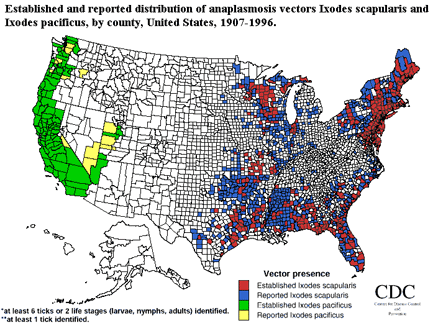Questions and Answers
- What is anaplasmosis?
- How do people get anaplasmosis?
- Where do most cases of anaplasmosis occur in the United States?
- What are the symptoms of anaplasmosis?
- How is anaplasmosis diagnosed?
- How is anaplasmosis treated?
- Can a person get anaplasmosis more than once?
- Why is CDC interested in this disease?
- How can Anaplasmosis be prevented?
- What is the best way to remove a tick?
What is anaplasmosis?
Anaplasmosis is a tick-borne disease caused by a species of bacteria called Anaplasma phagocytophilum. It was previously known as human granulocytic ehrlichiosis (HGE) and later as human granulocytic anaplasmosis (HGA). Both of these names refer to the same disease now known as human anaplasmosis.
How do people get anaplasmosis?
Anaplasmosis is transmitted to humans by tick bites primarily from the blacklegged tick (Ixodes scapularis) in the eastern United States and the western blacklegged tick (Ixodes pacificus) in the western United States. Of the four distinct phases in the tick life-cycle (egg, larvae, nymph, adult), nymphal and adult ticks are most frequently associated with transmission of anaplasmosis to humans. The disease also occurs in temperate regions outside of the United States. In these areas, Ixodes ricinus and Ixodes persulcatus serve as primary vectors.
Where do most cases of anaplasmosis occur in the United States?
Blacklegged ticks infected with A. phagocytophilum have been reported in New England, the Midwest, and southeastern states while western blacklegged ticks infected with A. phagocytophilum have been found along the pacific coast and in some southwestern states (see map below). Most human cases of anaplasmosis occur where the infected ticks are present. Occasionally someone who does not live in a tick-endemic area will become ill with anaplasmosis, possibly having been bitten by an infected tick during travel. If you traveled during the 3 weeks prior to becoming ill, you should tell your doctor.
About 600-800 cases of anaplasmosis are reported to CDC each year. States reporting the highest incidence of anaplasmosis in 2006 were Minnesota, Wisconsin, New York, New Jersey, and Connecticut.

Established and reported distribution of anaplasmosis vectors Ixodes scapularis and Ixodes pacificus, by county, United States, 1907 - 1996. Courtesy of the Division of Vector-Borne Infectious Diseases.
What are the symptoms of anaplasmosis?
The majority of people with anaplasmosis experience headaches, fever, chills, and muscle aches that can be confused with common diseases such as influenza. Onset of anaplasmosis generally begins within 3 weeks (5-21days) of a tick bite. The symptoms tend to be most severe in aged and immunosuppressed people. Some individuals who become infected with A. phagocytophilum do not become ill or experience only very mild symptoms and do not seek medical treatment.
How is anaplasmosis diagnosed?
Accurate diagnosis of anaplasmosis is often difficult because of the non-specific nature of the symptoms. An initial diagnosis is based on the patient's symptoms and a possible history of tick exposure. The diagnosis can only be confirmed by use of laboratory tests. Your doctor will take a blood sample to test for low white blood cell count, low platelet count, elevated levels of specific liver enzymes, the presence of specific antibodies produced by your body in response to infection with A. phagocytophilum, and/or use polymerase chain reaction (PCR) to detect the presence of A. phagocytophilum.
How is anaplasmosis treated?
The recommended treatment of anaplasmosis for children and adults is a tetracycline antibiotic, typically doxycycline. Prescribed antibiotics are usually taken for 10-14 days.
Can a person get anaplasmosis more than once?
Very little is known about immunity following an anaplasmosis infection. While it has been thought that infection may result in long-term immunity, there have been rare reports of laboratory-confirmed reinfection. Thus, even if you have previously been diagnosed with anaplasmosis, it is still necessary to be vigilant about avoiding tick bites and other tick-borne pathogens.
Why is CDC interested in this disease?
While the infection can usually be treated using a simple antibiotic, forgoing or delaying treatment for anaplasmosis can lead to serious, even fatal complications. Because anaplasmosis causes symptoms that are similar to other less severe diseases, many people do not receive prompt treatment. CDC monitors reports of infections to assist with health care education and public outreach programs that provide information about patterns of occurrence (who, when, where, how) and prevention of this disease.
How can Anaplasmosis be prevented?
See the Tickborne Rickettsial Diseases prevention page for tips on preventing anaplasmosis.
- Page last reviewed: April 1, 2008
- Page last updated: April 1, 2008
- Content source: Division of Viral and Rickettsial Diseases, National Center for Zoonotic, Vector-Borne, and Enteric Diseases
Get email updates
To receive email updates about this page, enter your email address:
Contact Us:
- Centers for Disease Control and Prevention
Division of Viral and Rickettsial Diseases (DVRD)
1600 Clifton Rd
Atlanta, GA 30333 - 800-CDC-INFO
(800-232-4636)
TTY: (888) 232-6348
24 Hours/Every Day - cdcinfo@cdc.gov


